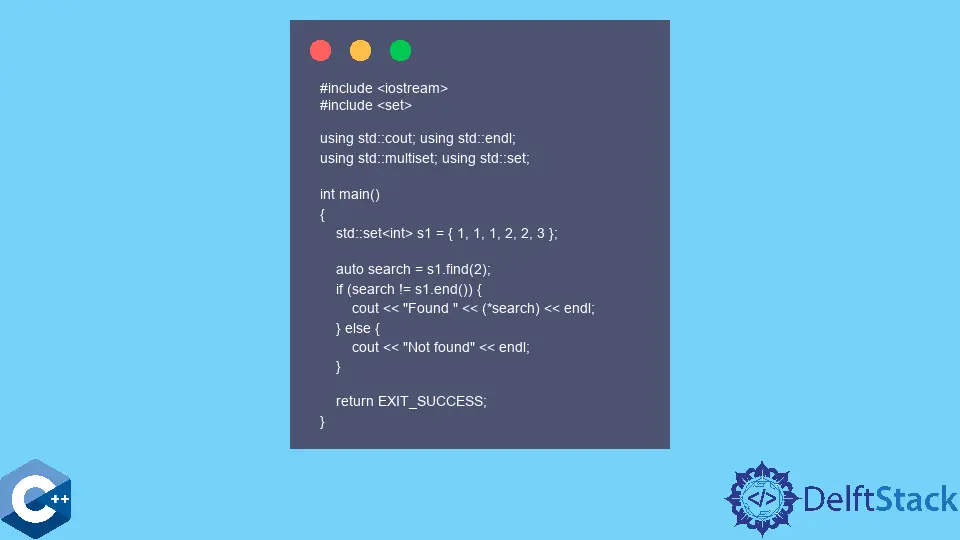在 C++ 中使用 STL Set Container
Jinku Hu
2023年10月12日
-
使用
std::set在 C++ 中声明设置容器对象 -
在 C++ 中使用
insert成员函数将元素插入到集合中 -
使用
find成员函数在 C++ 中检索具有给定键的元素的迭代器 -
在 C++ 中使用
contains成员函数检查具有给定键的元素是否存在于集合中

本文将演示有关如何在 C++ 中使用 STL set 容器的多种方法。
使用 std::set 在 C++ 中声明设置容器对象
std::set 命令将一组排序的唯一对象实现为关联容器。默认情况下,元素使用 std::less 比较函数排序,但用户可以提供自定义函数作为第二个模板参数。相同的标头还提供了 std::multiset 容器,它可以存储多个值而不过滤重复项。
请注意,我们在以下示例中使用初始化列表构造函数创建了两个集合对象。我们还利用了 count 成员函数,它检索具有给定键的集合中存在的元素数量。这个函数对于 std::multiset 容器来说更内在,但是当从 std::multiset 对象调用时,你可以检查元素是否存在相同的函数。
#include <iostream>
#include <set>
using std::cout;
using std::endl;
using std::multiset;
using std::set;
template <typename T>
void printSet(set<T> s) {
for (const auto &item : s) {
cout << item << "; ";
}
cout << endl;
}
template <typename T>
void printMultiSet(multiset<T> s) {
for (const auto &item : s) {
cout << item << "; ";
}
cout << endl;
}
#define STR(num) #num
int main() {
std::set<int> s1 = {1, 1, 1, 2, 2, 3};
printSet(s1);
std::multiset<int> s2 = {1, 1, 1, 2, 2, 3};
printMultiSet(s2);
std::cout << STR(s2) << " contains " << s2.count(1) << "ones" << endl;
std::cout << STR(s2) << " contains " << s2.count(2) << "twos" << endl;
return EXIT_SUCCESS;
}
输出:
1; 2; 3;
1; 1; 1; 2; 2; 3;
s2 contains 3 ones
s2 contains 2 twos
在 C++ 中使用 insert 成员函数将元素插入到集合中
insert 函数有多个重载,但我们使用带有单个参数的版本,表示要添加到集合中的元素。insert 的重载返回迭代器的 std::pair 对象和 bool。
后者表示插入是否成功,如果成功,它有一个 true 值。另一方面,当操作成功时,迭代器指向插入的元素。如果失败,则指向阻止插入的元素。请注意,插入操作在容器的大小上具有对数复杂度。
#include <cassert>
#include <iostream>
#include <set>
using std::cout;
using std::endl;
using std::multiset;
using std::set;
int main() {
std::set<int> s1 = {1, 1, 1, 2, 2, 3};
auto ret = s1.insert(5);
assert(*ret.first == 5);
if (ret.second) std::cout << "Inserted!" << endl;
ret = s1.insert(1);
assert(*ret.first == 1);
if (!ret.second) std::cout << "Not inserted!" << endl;
return EXIT_SUCCESS;
}
输出:
Inserted!
Not inserted!
使用 find 成员函数在 C++ 中检索具有给定键的元素的迭代器
find 函数是 std::set 容器的另一个有用的成员函数,它可以将迭代器返回到具有给定键的元素。如果集合中没有这样的元素,则返回尾后迭代器;这有助于用户验证成功的函数调用。
#include <iostream>
#include <set>
using std::cout;
using std::endl;
using std::multiset;
using std::set;
int main() {
std::set<int> s1 = {1, 1, 1, 2, 2, 3};
auto search = s1.find(2);
if (search != s1.end()) {
cout << "Found " << (*search) << endl;
} else {
cout << "Not found" << endl;
}
return EXIT_SUCCESS;
}
输出:
Found 2
在 C++ 中使用 contains 成员函数检查具有给定键的元素是否存在于集合中
由于 C++20 语言标准,std::set 提供了成员函数 contains,这是检查具有给定键的元素是否存在于 set 对象中的更简单的接口。该函数返回布尔值以指示集合中是否存在此类元素。这个函数的运行时间复杂度也是容器大小的对数。
#include <iostream>
#include <set>
using std::cout;
using std::endl;
using std::multiset;
using std::set;
int main() {
std::set<int> s3 = {91, 123, 63, 122, 22, 53};
for (int x : {22, 23, 53, 54}) {
if (s3.contains(x)) {
cout << x << ": Found\n";
} else {
cout << x << ": Not found\n";
}
}
return EXIT_SUCCESS;
}
输出:
22: Found
23: Not found
53: Found
54: Not found
作者: Jinku Hu
